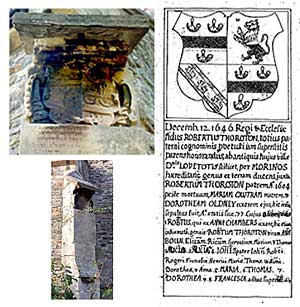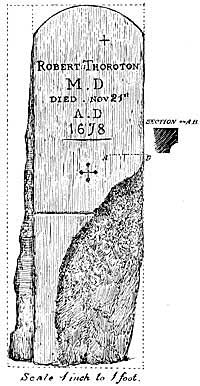
Artefactual
Stone coffin at Car Colston Church
 Thoroton's stone coffin
Thoroton's stone coffinIn 1672, Dr Thoroton ordered a stone coffin to be made, so that, according to an inscription cut in the floor of the coffin, ‘after death his body might rest undisturbed’. In his will, he reiterated that ‘my body [is] to be buried in the stone coffin at Car Colston which I have prepared for it’. The coffin lid bears the inscription: ‘Robert Thoroton, M.D., the husband of Anne Boun; the father of Anne wife of Philip Sherard Esq., and of Elizabeth wife of John Turner; was buried 21st day of Nov. 1678’.
The coffin was described by one commentator as ‘massive and elegant’. It is decorated with coats of arms, sculptured in relief, of Thoroton and his related families including Lovetot and Morin on the one side, Bohun (alias Boun), Tibtot and Hunt on the others, and the Sherards (his chief heirs) on the lid. According to measurements taken at the end of the 19th century, ‘the coffin is 87 inches long and 32 inches wide at the shoulders; 29 inches high at the head and 23 inches at the foot. The sides and ends are three inches thick, and the trough 12 inches deep’. The coffin and its stone lid were accidently discovered in 1845 just two feet below the surface of the ground near the chancel door.
It is perhaps not surprising that the coffin was buried to a shallow depth as it was presumably too heavy to be buried any deeper in the ground. It was covered up when discovered in 1845 and was rediscovered in 1863 when it was dug up and moved into the vestry. Tradition has it that Thoroton’s skull was removed and placed on show in a neighbouring cottage for school children and visitors to see, until the incumbent insisted on its being re-interred. If this is the case, we might echo the comments of Lawson Lowe who examined the coffin at the start of the twentieth century:
This is an unusually late example of a stone coffin, and the use of it in this case may doubtless be attributed to the antiquarian predilections of the learned doctor. That the coffin itself is an object of more than ordinary interest cannot be denied, but at the same time it is a matter of great regret that the mortal remains of Dr Thoroton should not have been suffered to rest in peace in the receptacle which, from its peculiarity, we may presume was provided at his own particular direction and was not unlikely prepared by him in his lifetime.
Memorial tablet on external buttress at Car Colston Church
 Memorial buttress tablet.
Memorial buttress tablet.A few feet from the base of the buttress of the south side, on the upper part of the buttress, is a small memorial tablet, placed there by Dr Thoroton in 1664 to mark the last resting-place of his great-grandfather, grandfather, and some two dozen other members of his family. The tablet is about three feet high and one and a half feet wide; an inscription, arranged in seventeen lines, takes up the lower part of the stone, the upper part having the family bearings sculptured in relief.
The care with which Thoroton executed the memorial is demonstrated by the survival of three different manuscript versions of the text. It is carved in Latin and contains what is effectively a family pedigree which names four generations of Thoroton’s family, including the great-grandfather who died of the plague in 1604 and his grandfather who died in 1646, as well as Thoroton’s siblings. Thoroton left a draft plan of the layout and wording.
Grave Marker for Dr Thoroton, Car Colston Church
 Grave marker to Robert Thoroton M.D.
Grave marker to Robert Thoroton M.D.In September 1901, a grave marker was discovered paving the graveyard path close to Thoroton’s grave. The discovery was described in the Thoroton Society’s Transactions by Thomas Blagg:
[I] noticed a large slab, which had been uncovered, and which lay lengthways of the path, close to the spot where Thoroton was buried, and which had evidently been placed in that position for the purpose of paving the pathway… I had the stone raised to see if its other side bore the usual five crosses indicative of an altar stone. This I found to be the case, two of the crosses (that in the centre and one of the corner ones) still remaining. The others appear to have been lost by the shaping of the stone to its later purpose, or by the desecrators' hammers or the natural decay which has destroyed a large part of its surface.
The stone is probably recycled remains of an altar table adapted to mark the site of Thoroton’s coffin.
Memorial tablet by members of the Thoroton Society, Car Colston Church
In 1906, the Thoroton Society launched an appeal to raise money for a suitable brass memorial to be erected at Car Colston in memory of Dr Thoroton. The subscription only reached £39, so the deficit was made up privately, but the ‘perceived lack of enthusiasm from Society members explains the wording of the inscription: “erected by a few members of the Society”’. The memorial, installed in the south aisle, was unveiled during a Society excursion in 1908, which included a short dedication service. After the Bidding Prayer had been said, George Fellows, a descendant of Thoroton’s sister Mary, unveiled the memorial ‘in memory of Robert Thoroton, Doctor and Historian, whose memory in this place they are anxious should not be forgotten, but rather, that he being dead should yet speak to us’.